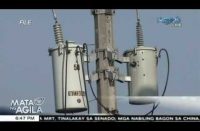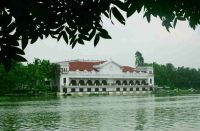(Eagle News)–Tropical Storm “Pepito” has crossed Northern Luzon and is now over the Lingayen Gulf.
The Philippine Atmospheric Geophysical and Astronomical Services Administration said Signal No. 2 is hoisted over Ilocos Sur, La Union, Pangasinan, Benguet. Tarlac, and the northern portion of Zambales (Iba, Palauig, Masinloc, Candelaria, Santa Cruz, Botolan, Cabangan) with “Pepito” 40 kilometers north northwest of Dagupan City, Pangasinan.
It is packing maximum sustained winds of 75 kph near the center and gustiness of up to 115 kph.
Signal no. 1, on the other hand, is raised over Ilocos Norte, Kalinga, Abra, Ifugao, Mountain Province, the southern portion of Isabela (Palanan, San Mariano, Benito Soliven, Naguilian, Gamu, Burgos, San Manuel, Aurora, Cabatuan, Luna, Reina Mercedes, Cauayan City, Dinapigue, San Guillermo, Angadanan, Alicia, San Mateo, Ramon, San Isidro, Echague, San Agustin, Jones, Santiago City, Cordon), Quirino, Nueva Vizcaya, Aurora, Nueva Ecija, Bulacan, Pampanga, the rest of Zambales, and Bataan.
The tropical cyclone wind signal in other areas, including in Metro Manila, has been lifted.
PAGASA said “Pepito” is forecast to move generally west over the West Philippine Sea today at 30 kph, before slowing down and turning northwest tomorrow.
It is forecast to exit the Philippine Area of Responsibility (PAR) tomorrow morning or afternoon.
“Pepito” will accelerate and turn westward beginning Friday towards the central portion of Vietnam, and is forecast to gradually intensify over the West Philippine Sea.
It may reach the severe tropical storm category by tomorrow afternoon or evening.
Today, the tropical storm will bring moderate to heavy rains over Batanes, Cagayan, Ilocos Norte, Pangasinan, La Union, Apayao, Benguet, Zambales, Bataan, Occidental Mindoro, and Calamian Islands.
Light to moderate with at times heavy rains will be experienced over Metro Manila and the rest of Luzon.
“Flooding (including flash floods) and rain-induced landslides may occur during heavy or prolonged rainfall especially in areas that are highly or very highly susceptible to these hazards,” PAGASA said.
Gale-force winds and high (strong to near gale) winds will be experienced in areas under signal number 2 and 1, respectively, according to the weather bureau, while high to gale-force winds due to the northeasterly surface wind flow will be experienced over the rest of northern Luzon, especially in coastal and mountainous areas.
As for coastal waters, rough to very rough seas will be experienced over the areas where signal number 1 and 2 and the gale warning are in effect, or over the entire seaboards of Northern and Central Luzon, the seaboard of northern Quezon including Pollilo Islands, and the western seaboards of Batangas, Occidental Mindoro (including Lubang Islands), and Palawan (including Calamian and Kalayaan Islands).
PAGASA said this means sea travel is risky over these areas, especially for those using small seacraft.
Moderate to rough seas, on the other hand, will prevail over the eastern seaboards of southern Quezon, Bicol Region, Eastern Visayas, Caraga, and Davao Region.
Those with small seacraft have been advised to take precautionary measures when venturing out to sea.







